-

人教版新目标初中英语九年级下册Rainy days make me sad教案
1. 教材分析本单元以how do things affect you?为话题, 从颜色、天气、音乐、广告、产品等方面谈论了外界事物如何影响人的心情。要求学生掌握表达某物或某事给人带来的感觉、看法或影响等。共设计了四个部分的内容:Section A 该部分有4个模块:第一模块围绕Which restaurant would you like to go to?这一话题展开思维(1a)、听力(1b)、口语(1c)训练;第二模块围绕How does music affect you? 进行听力(2a-2b)、口语训练(2c);第三模块继续围绕how do colors in the restaurant affect you这一话题展开训练,训练形式为阅读和问题体验(3a)和小组活动(3b);第四模块仍就How do things affect you这一话题以调查的形式展开讨论。Section B该部分有4个模块:第一模块围绕产品广告对人们的影响这一话题以“配对”(1a)与“列举”(1b)两种形式展开训练;第二模块继续围绕How do things affect you? 进行听力(2a-2b)、口语对话训练(2c);第三模块围绕“Advertising”这一话题展开阅读(3a-3b)和写作(3c)训练;第四模块围绕How posters affect you这一话题以口语训练形式展开小组活动。

人教版新目标初中英语九年级下册Could you please tell me where the restrooms are教案
Step Ⅰ RevisionCheck homework. Ask a few students to read the article in 3a.Then ask a few students to read their guides.Step Ⅱ Part 1Look at the words in the box. Ask a student to read them. Make sure the students understand the meaning of the words. You are to fill in the blanks with the words. In some cases, students may need to use another form of the word, for example adjusting for tense or subject/ verb agreement.Ask students to fill in the blanks on their own.Check the answers. Step ⅢPart 2Go through the instructions with the class.Look at the example with the students.Ask students what the answer would be.Ask a student to read the question and answer it.Excuse me, could you tell me where the bank is, please?The bank is across the street from the shopping malt.Get students to complete the work in pairs.Check the answers. Ask a few students to read their questions.Step Ⅳ Just for Fun!Ask all the students to read the conversation. Ask: What is funny about this cartoon? Help students to explain. A Martian is a person from the planet Mars.There is no such thing as Martian food on Earth, and the clerk looks silly because he is trying to think of where there is a Martian restaurant.Invite some pairs of students to present this conversation to the rest of the class.Step Ⅴ Summary and HomeworkIn this class, we’ve done much writing practice using the key vocabulary words and the target language presented in this unit. After class, please finish the questions in 2 in your exercise books. Then finish the exercises on pages 47~48 of the workbook as well.The Seventh Period Ⅰ Teaching Aims and Demands1. Knowledge Objects(1) Key Vocabularyimage, adventure, jealousy, hero, crime, journey, brave, no longer, show interest in, take it easy, become interested in, plain looks(2)Text:Grown-ups like cartoons, too.2. Ability Objects(1) Fast-reading to get a general idea of the text.(2) Careful-reading to get the detailed information in the text.

人教版新目标初中英语九年级下册I’ll help clean up the city parks教案
Talk about offering help (P60)I’ll help clean up the city parks.A: I’d like to work ...B: You could help ...Talk about ways to tell people about the Clean-Up Day (P61)We need to ...We can’t ...I’ll ...Talk about the work the volunteers do (P62)These three students all volunteer their time to help other people.Somebody loves to ... / helps ... / plans to ... / wants to ...A: What do you like doing?B: I like ... A: What kind of volunteer work do you think I could do?B: You could ...1. 重点词汇advertisement, fix, repair, pleasure, blind, deaf, shut, carry, specially, fetch2. 认读词汇hunger, homeless, cheer, clean-up, sign, establish, major, commitment, elementary, veterinarian, coach, similar, call-in, strategy, disabled, organization, unable, support, appreciate, donation, part of speech, pronoun, adverb, preposition, conjunction, donate, Jimmy, Sally3. 词组clean up, cheer up, give out, put off, set up, think up, take after, fix up, give away, put up, hand out, work out, at once

人教版新目标初中英语七年级下册Where did you go on vacation教案
句型: Where did you go on vacation? I went to summer camp.Did she go to Central Park?Yes,she did.No, she didn’t语法:一般过去时特殊疑问句、一般疑问句及肯、否定回答。课时安排4课时第一课时:Section A:la,1b,lc,2a,2b,2c 第二课时:Section A:3a,3b,4第三课时:Section B:1,2a,2b,2c第四课时:Section B:3a,3b,3c,4 and Self Check第一课时教学目标掌握描写假期生活的形容词。假期里自己所做事情的简单表达。谈论假期做的事情及当时情况。谈论假期时旅游的天气,旅游者以及食物等。教学过程一、导入播放一首英文歌曲:Let’s travel 说明:通过让学生听节奏欢快迪斯尼英语歌曲Let’s travel.引入本节课谈论的话题vacation and travel. 让歌曲使学生的思维活跃,增强课堂气氛,激发学生提高学习英语的兴趣。T:How is the trip ?Ss : It’s pretty good/ happy/exciting /relaxing/busy/dangerous/ fantastic说明:这个问题是为了操练形容词。建议让多个Ss作答。鼓励他们用不同的形容词。上述个别形容词本应在第二课时中出现,但可以在warming-up中第一次非正式出现。这些形容词也可在老师的评价语中适时出现,以加深学生对词汇的印象。

人教版新目标初中英语八年级下册Would you mind turning down the music教案
Step 4. Group work (4)1. Ask a pair of students to read the dialogue. Say, This activity provides speaking, listening and writing practice using the target language.2. Ask students to complete the work in groups.3. Check the answers with the whole class. 4. Explain some of the language points. Step 5. Word review (Self check 1)1. Ask students to read the words and the phrases given. 2. Fill in the blanks with proper forms of these words to complete the sentences. 3. Check the answers with the whole class. Homework:Do activity 2 on page 57 after class. Period 6Teaching aims: 1. Teach vocabulary words and the useful expressions. 2. Enable the students to learn etiquette in different culture. 3. Help the students learn how to behave politely in public places and in daily life. Teaching procedures:Step 1. RevisionHelp students to review the function of making requests through a free talk. Then lead them to the topic of etiquette. Explain the meaning of etiquette. Or, ask students to look it up in the dictionary. Step 2. Pre-reading (Section 1)1. Ask students to read the picture and make a list with their partner about how many rules of etiquette can be seen being broken.

人教版新目标初中英语九年级下册By the time I got outside, the bus had already left教案
Ⅰ. Teaching Aims and Demands1. Knowledge Objects(1) Key Vocabularyoversleep(2) Target LanguageWhat happened?I overslept. And by the time I got up, my brother had already gotten in the shower.2. Ability Objects(1) Teach the students to use the new words.(2) Train the students to narrate past events with the Past Perfect Tense.(3) Train the students' listening and speaking skills with the target language.3. Moral ObjectIt’s a good habit to go to bed early in the evening and get up early in the morning. So you’ll never be in a hurry in the morning.Ⅱ. Teaching Key Points1. Key Vocabularyoversleep2. Target LanguageNarrate past events with the Past Perfect TenseⅢ. Teaching Difficult Points1. Train the students to narrate past events with the Past Perfect Tense.2. Train the students to understand the target language in spoken conversation.Ⅳ. Teaching Methods1. Thinking of examples from the students' real lives.2. Making sentences by looking at the pictures.Ⅴ. Teaching AidA tape recorderⅥ. Teaching ProceduresStep I Revision1. Revise the language points in Unit 8.Ask some questions like this: What volunteer work would you like to do?Help the students to answer, I’d like to…/I love to…/I hope to2. Practice the dialogue in Activity 3c on page 62 again. Get students to role play the similar dialogues with the following.

人教版新目标初中英语九年级下册You’re supposed to shake hands教案
教学目标:1. 掌握本单元一些重点词汇的写法和用法。2. 学会自如谈论餐桌礼仪。Step 1 RevisionAsk some students to retell the customs at the table in France in the passage in 3a.Step 2 Self checkPart 1. Fill in each bland with the correct word given. Students do the exercises by themselves at first. Then check the answers. Ask the students to comprehend the sentences and help them point out uses of some words, like “arrive (at / in) sw., spend time / money on sth , spend time / money (in) doing sth.”Part 2. Read about Fan Ling’s experience in a western restaurant. Understand the passage. Point out some key points in the passage.1. be / get used to doing sth. 习惯做某事2. begin with = start with 以….开头3. crowd v. 挤满,塞满 the crowd 人群 crowded adj. 拥挤的Then students discuss about how she would solve her problem. Ask some to share their stories with others.Part 3. Complete the crossword by looking at the sentences on the left. Then check the answers.

人教版新目标初中英语七年级下册What does he look like教案3篇
所需要用到的句子:Who is that?That is Jack. I like him.Why do you like him?I like him because he is interesting.Task 4: 设计理想中的人类Step one: 设计理想中的人类的外貌。把全班同学分成若干小组,学生可以边说边在纸上画出他们的模样。Step two: 设计理想中人类的性格。学生们可以把那些能描述性格的单词写在图画的旁边。Step three: 每组选出一名同学,其他同组同学提问,他作简单回答,并说明原因。所需用到的句子:What does he or she look like?He or she ...What is he or she like?He or she is ...Why?Because ...Task 5: 挑战性活动调查性格是天生的还是后天形成的,让每个同学回家去调查一下自己成长过程中性格是否有变化,具体是怎样的,为什么会这样? Teaching Aims:1. Enable students to have a general understanding of how to talk about people's physical appearance.2. Enable students to tackle some essential vocabularies and patterns about describing people. Provide them with necessary skills and methods.3. Create various chances for students to describe the persons they're familiar with, such as classmates, family members, teachers, idols, etc.

人教版新目标初中英语八年级下册Have you ever been to an amusement park教案
(1)Have you ever been to …? Yes, I have. / Yes, I have ever been to …No, I haven’t. / No, I have never been to …(2)When did you go there? I went there last year. (3)I have never been to a water park. Neither have I. I have ever been to an amusement park. So have I. (4)How long have you been studying English? I’ve been studying English since nine o’clock. I’ve been studying English since I came back home. I’ve been studying English for five hours. (5)What’s that? It’s an amusement park in Japan. I’ve never been to an amusement park like it before. It’s fun to learn another language. Let’s go tonight. Isn’t this great?space museum, amusement park, water park, South America, Peru, Holland, European culture, tour guide, flight attendant, musical instrument, more than, be from, get to, take lessons, neither, discover, graduate, change
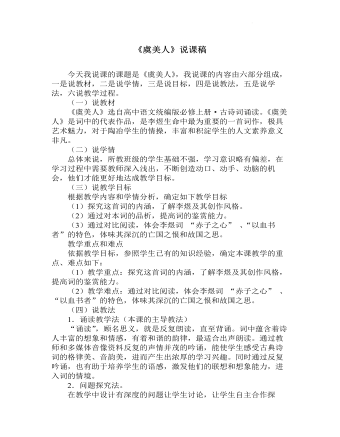
古诗词诵读《虞美人(春花秋月何时了)》说课稿 2021-2022学年统编版高中语文必修上册
(一)说教材 《虞美人》选自高中语文统编版必修上册·古诗词诵读。《虞美人》是词中的代表作品,是李煜生命中最为重要的一首词作,极具艺术魅力,对于陶冶学生的情操,丰富和积淀学生的人文素养意义非凡。(二)说学情总体来说,所教班级的学生基础不强,学习意识略有偏差,在学习过程中需要教师深入浅出,不断创造动口、动手、动脑的机会,他们才能更好地达成教学目标。(三)说教学目标根据教学内容和学情分析,确定如下教学目标(1)探究这首词的内涵,了解李煜及其创作风格。(2)通过对本词的品析,提高词的鉴赏能力。(3)通过对比阅读,体会李煜词 “赤子之心” 、“以血书者”的特色,体味其深沉的亡国之恨和故国之思。
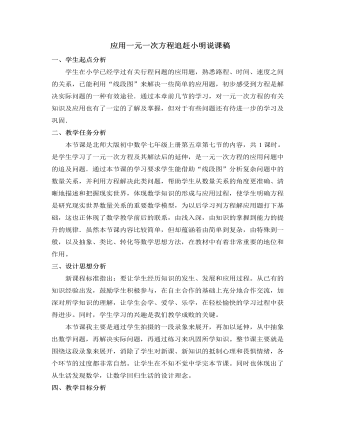
北师大初中数学七年级上册应用一元一次方程追赶小明说课稿
目的:进一步理解追击问题的实质,与课程引入中的灰太狼追喜羊羊故事呼应,问题得到解决。环节三、运用巩固活动内容:育红学校七年级学生步行郊外旅行,1班的学生组成前队,步行速度为4千米/小时,3班的学生组成后队,步行速度为6千米/小时,1班出发一个小时后,3班才出发。请根据以上的事实提出问题并尝试回答。问题1:3班追上1班用了多长时间 ?问题2:3班追上1班时,他们离学校多远?问题3:………………目的:给学生提供进一步巩固建立方程模型的基本过程和方法的熟悉机会,让学生活学活用,真正让学生学会借线段图分析行程问题的方法,得出其中的等量关系,从而正确地建立方程求解问题,同时还需注意检验方程解的合理性.实际活动效果:由于题目较简单,所以学生分析解答时很有信心,且正确率也比较高,同时也进一步体会到了借助“线段图”分析行程问题的优越性.
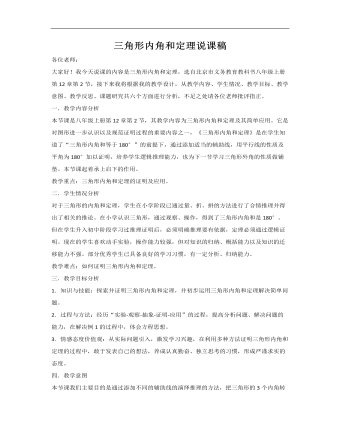
初中数学北京课改版八年级上册《122三角形的性质》说课稿
一.学生情况分析对于三角形的内角和定理,学生在小学阶段已通过量、折、拼的方法进行了合情推理并得出了相关的推论。在小学认识三角形,通过观察、操作,得到了三角形内角和是180°。但在学生升入初中阶段学习过推理证明后,必须明确推理要有依据,定理必须通过逻辑证明。现在的学生喜欢动手实验,操作能力较强,但对知识的归纳、概括能力以及知识的迁移能力不强。部分优秀学生已具备良好的学习习惯,有一定分析、归纳能力。
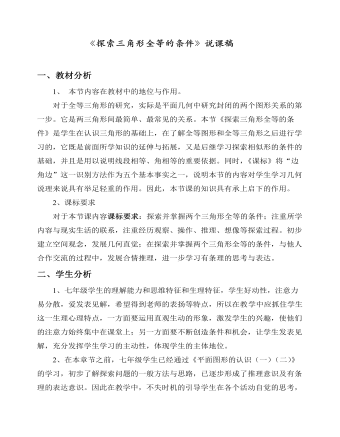
初中数学苏科版八年级上册《探索三角形全等的条件12》说课稿
2、课标要求对于本节课内容课标要求:探索并掌握两个三角形全等的条件;注重所学内容与现实生活的联系,注重经历观察、操作、推理、想像等探索过程。初步建立空间观念,发展几何直觉;在探索并掌握两个三角形全等的条件,与他人合作交流的过程中,发展合情推理,进一步学习有条理的思考与表达。二、学生分析 1、七年级学生的理解能力和思维特征和生理特征,学生好动性,注意力易分散,爱发表见解,希望得到老师的表扬等特点,所以在教学中应抓住学生这一生理心理特点,一方面要运用直观生动的形象,激发学生的兴趣,使他们的注意力始终集中在课堂上;另一方面要不断创造条件和机会,让学生发表见解,充分发挥学生学习的主动性,体现学生的主体地位。
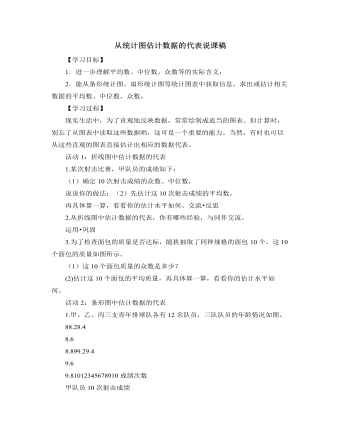
北师大版初中八年级数学上册从统计图估计数据的代表说课稿
1.小明调查了班级里20位同学本学期计划购买课外书的花费情况,并将结果绘制成了下面的统计图.(1)在这20位同学中,本学期计划购买课外书的花费的众数是多少?(2)计算这20位同学计划购买课外书的平均花费是多少?你是怎么计算的?反思?交流*(3)在上面的问题,如果不知道调查的总人数,你还能求平均数吗?2.某题(满分为5分)的得分情况如右图,计算此题得分的众数、中位数和平均数。活动4:自主反馈1.下图反映了初三(1)班、(2)班的体育成绩。(1)不用计算,根据条形统计图,你能判断哪个班学生的体育成绩好一些吗?(2)你能从图中观察出各班学生体育成绩等级的“众数”吗?(3)如果依次将不及格、及格、中、良好、优秀记为55、65、75、85、95分,分别估算一下,两个班学生体育成绩的平均值大致是多少?算一算,看看你估计的结果怎么样?*(4)初三(1)班学生体育成绩的平均数、中位数和众数有什么关系?你能说说其中的理由吗?
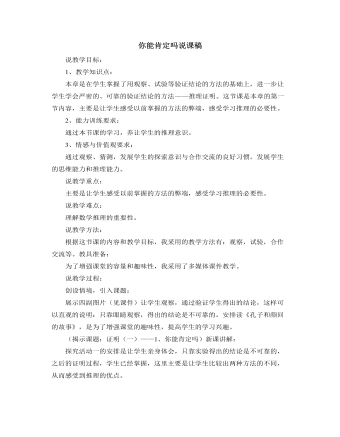
北师大版初中八年级数学上册你能肯定吗说课稿
探究活动二的安排,是要让学生明确只靠实验得出的结论,可能会以点带面,从而进一步说明学习推理的必要性。并小结出:如果要判断一个结论不正确只要举一个反例就可以了。探究活动三的安排是说明只靠实验得出的结论也不可靠,必须经过有根有据的推理才行。活动交流:(1)在数学学习中,你用到过推理吗?(2)在日常生活中,你用到过推理吗?这是一座桥梁,把课堂引向推理的方法。例题的安排,可以让学生学会简单的推理方法,同时增强学生的学习兴趣。课堂练习:①游戏:苹果在哪里?②判断:是谁打破玻璃?把练习变成游戏的形式,也是为了增加课堂的趣味性,提高学生的学习兴趣。课堂小结:进一步明确学习推理的必要性。课后作业:①课本习题6.1:2,3。②预习下一节:定义与命题
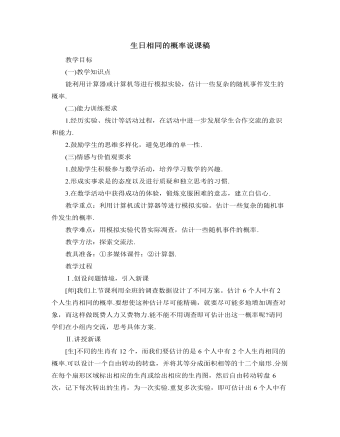
北师大版初中数学九年级上册生日相同的概率说课稿
Ⅵ.活动与探究某种“15选5”的彩票的获奖号码是从1~15这15个数字小选择5个数字(可以重复),若彩民所选择的5个数字恰与获奖号码相同,即可获得特等奖.小明观察了最近100期获奖号码,发现其中竟有51期有重号(同一期获奖号码有2个或2个以上的数字相同),66期有连号(同一期获奖号码中有2个或2个以上的数字相邻).他认为获奖号码不应该有这么多重号和连号,获奖号码可能不是随机产生的,有失公允.小明的观点有道理吗?重号的概率大约是多少?利用计算器模拟实验可以估计重号的概率.[过程]两人组成一个小组,利用计算器产生1~15之间的随机数.并记录下来,每产生5个随机数为一次实验,每组做10次实验,看看有几次重号和连号.将全班的数据汇总集中起来,就可估计出1~15之间的整数中随机抽出5个数出现重号和连号的概率.

北师大版初中数学九年级上册相似三角形的判定说课稿
(四)提高应用已知:在△ABC中,已知∠ACB=90°,CD⊥AB于D,请找出图中的相似三角形,并说明理由。设计意图:训练学生灵活运用知识的能力(五)小结反思1.、相似三角形的判定方法一:如果一个三角形的两个角分别与另一个三角形的两个角对应相等,那么这两个三角形相似. 2、在找对应角相等时要十分重视隐含条件,如公共角、对顶角、直角等. 3、掌握由平行线构造的两类相似图形:一类是A字型,另一类是X型. (回顾定理,强调两个基本图形,培养学生养成认真观察,注意寻找图形中的隐含信息的意识) 4、 常用的找对应角的方法:①已知角相等;②已知角度计算得出相等的对应角;③公共角;④对顶角;⑤同角的余(补)角相等.
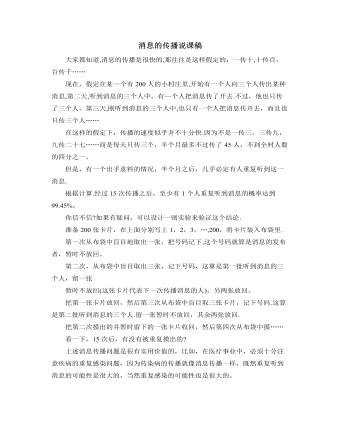
北师大版初中数学九年级上册消息的传播说课稿
准备200张卡片,在上面分别写上1,2,3,…,200,将卡片装入布袋里.第一次从布袋中盲目地取出一张,把号码记下,这个号码就算是消息的发布者,暂时不放回。第二次,从布袋中盲目取出三张,记下号码,这算是第一批听到消息的三个人,留一张暂时不放回(这张卡片代表下一次传播消息的人),另两张放回。把第一张卡片放回,然后第三次从布袋中盲目取三张卡片,记下号码.这算是第二批听到消息的三个人.留一张暂时不放回,其余两张放回.把第二次摸出的并暂时留下的一张卡片收回,然后第四次从布袋中摸……看一下,15次后,有没有被重复摸出的?上述消息传播问题是很有实用价值的,比如,在医疗事业中,必须十分注意疾病的重复感染问题,因为传染病的传播就像消息传播一样,既然重复听到消息的可能性是很大的,当然重复感染的可能性也是很大的。
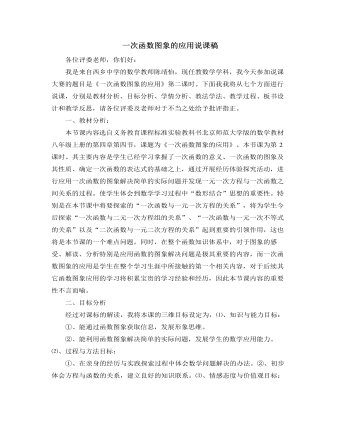
北师大版初中八年级数学上册一次函数图象的应用说课稿
本环节运用了一个阶梯式的问答方法,帮助突破本节课的难点。同时,从具体的实际问题入手,由特殊问题到一般规律的揭示,不仅解决了难点问题,而且从另外一个角度讲也渗透给了学生的数形结合思想,还有利于学生主动探索意识的培养。4、自主评价本环节主要是应用本节课所学的知识以及所积累形成的学习经验和体验解决问题的过程,即课堂巩固训练。在练习题的选择上,由简单到复杂。先是结合图象获取信息进行简单的填空和选择,此题属于A组题型,检验学生的掌握情况;然后进行了一道B组题,关于“一次函数与一元一次方程的关系”知识点的灵活运用,进一步通过练习体会它们的关系。5、自主发展:最后一道则是特殊的区别于之前所学习的分段函数练习,发散学生思维问题的训练。让学生体会分段函数的特点,并掌握求分段函数解析式的方法。
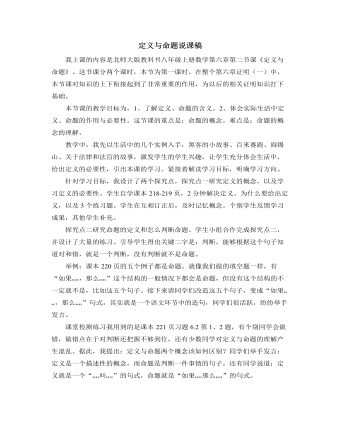
北师大版初中八年级数学上册定义与命题说课稿
接下来请同学们改造这五个句子,变成“如果??,那么??”句式,其实就是一个语文环节中的造句,同学们很活跃,纷纷举手发言。课堂检测练习我用到的是课本221页习题6.2第1、2题,有个别同学会做错,做错点在于对判断还把握不够到位,还有少数同学对定义与命题的理解产生混乱。据此,我提出:定义与命题两个概念该如何区别?同学们举手发言:定义是一个描述性的概念,而命题是判断一件事情的句子。还有同学说道:定义就是一个“??叫??”的句式,命题就是“如果??那么??”的句式。在教学中,学生对定义与命题的把握还是比较清楚的。大部分学生可以口头完成导学案设计的题目。能够迅速的把一个命题转化成“如果?那么?”的形式.利用疑问句和祈使句的特点,判定不是命题的语句.迅速的掌握情况还是比较可以的。

